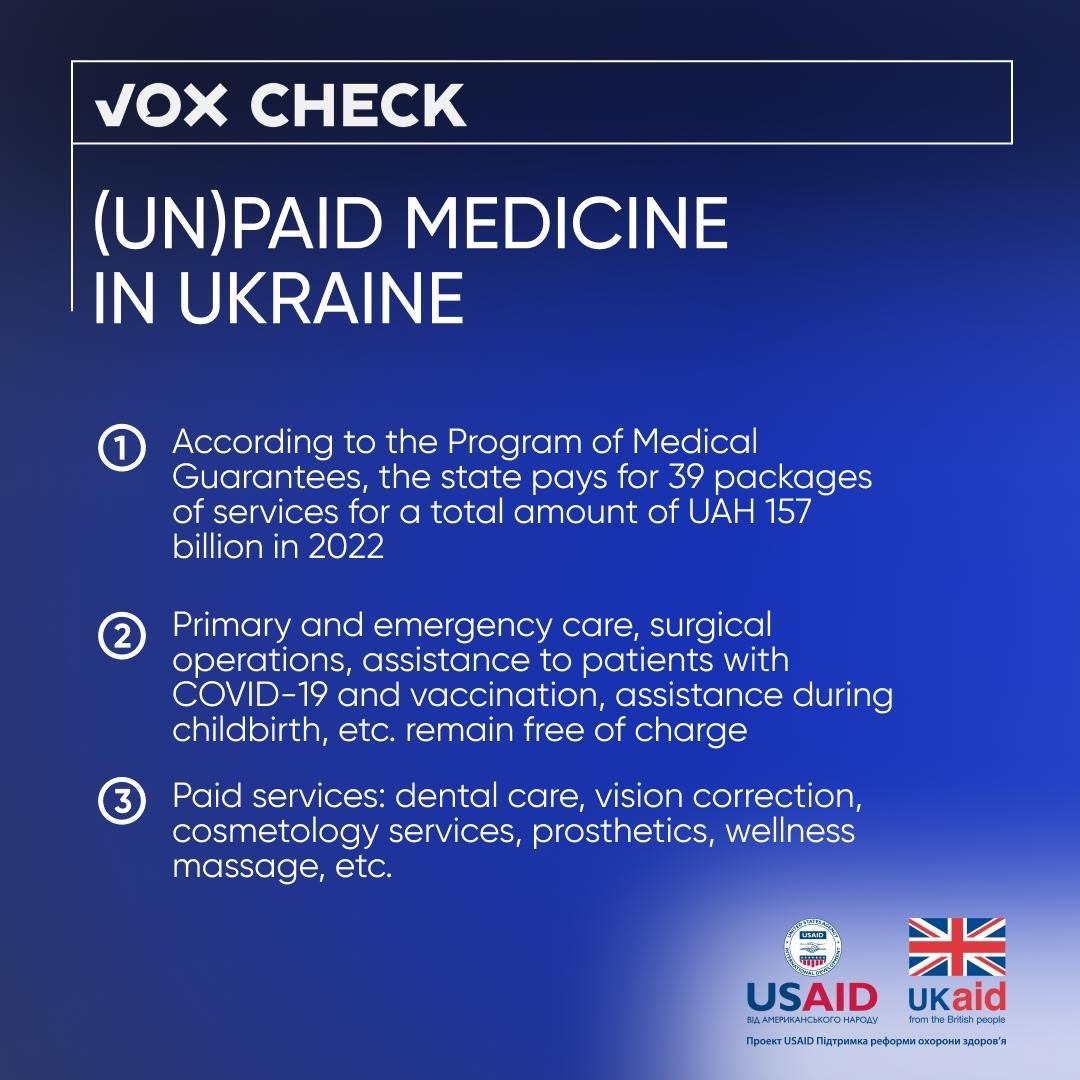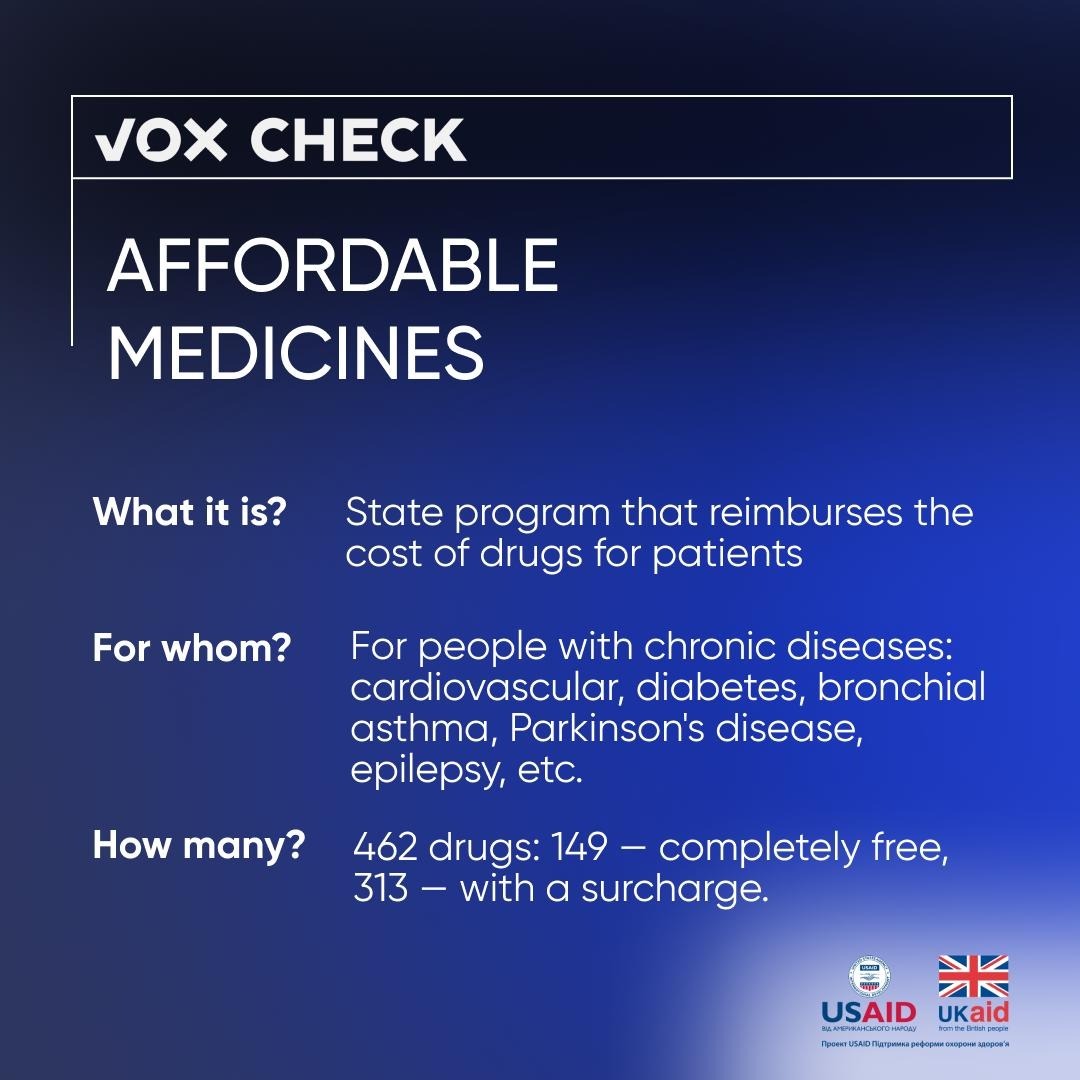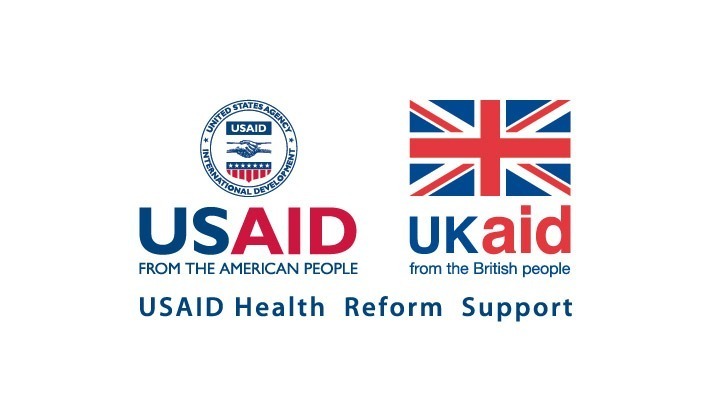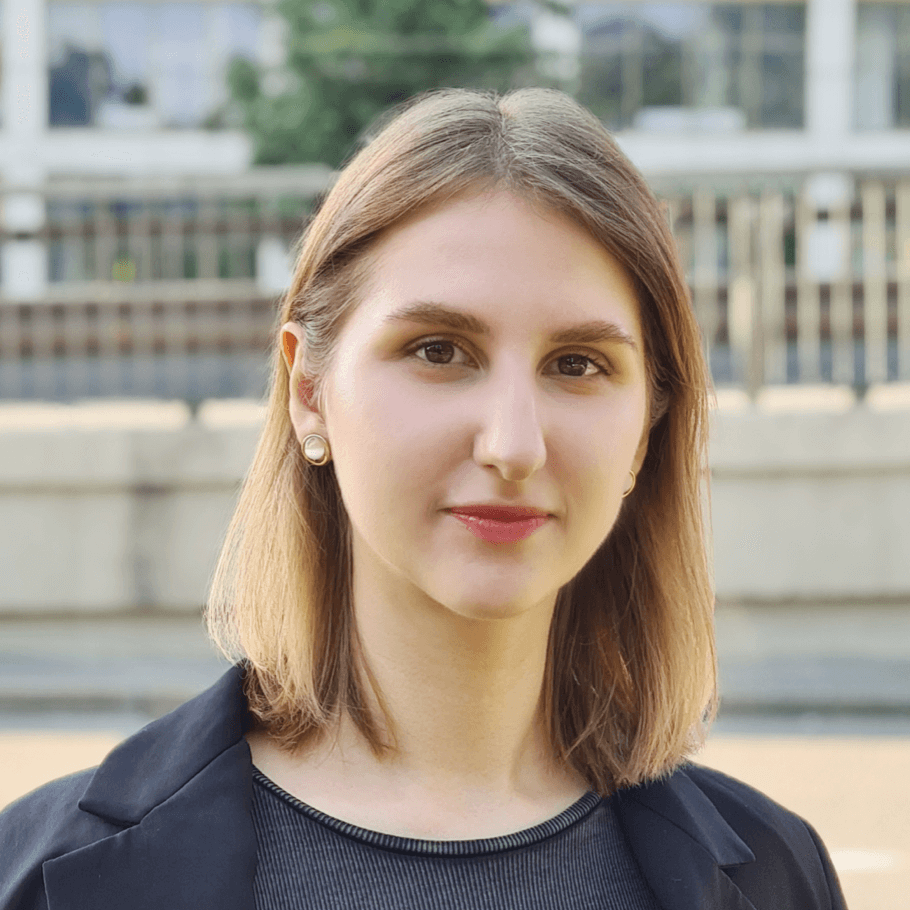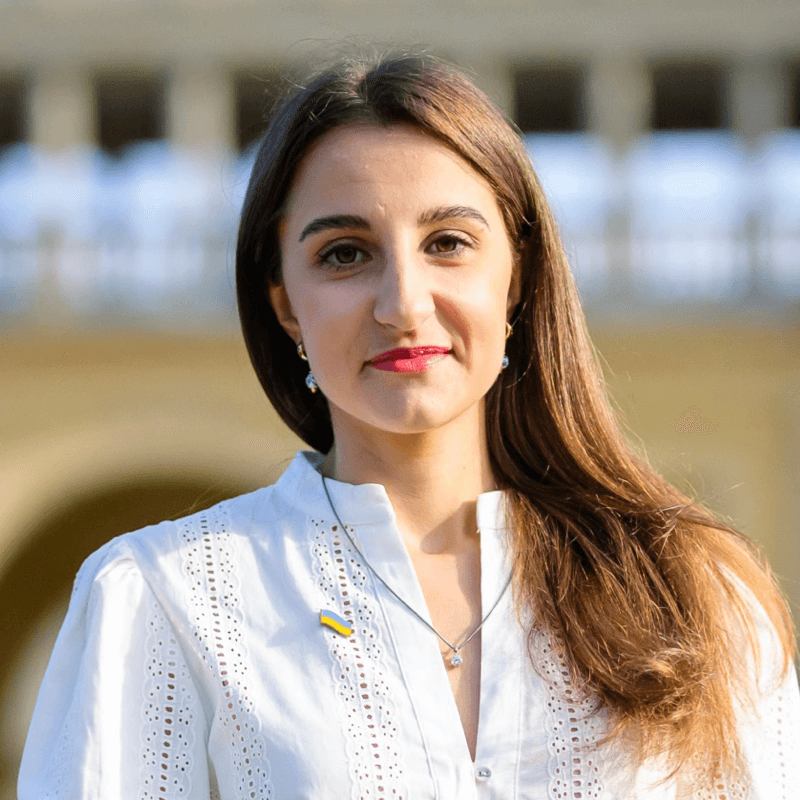“Murderous reform”, “destruction of state medicine”, and “doctor death” — this is how Russian propaganda described medical reform in Ukraine. Attempts to discredit the reform did not stop even during the full-scale invasion of the Russian Federation. In this article, we refute three fakes about the medical system in Ukraine in 2022.
With the support of the USAID Health Reform Support project, VoxCheck analyzes and refutes public health narratives spread in the information space of Ukraine, Belarus, and russia on a weekly basis.
Discrediting the reforms is one of the popular topics of Russian propaganda about Ukraine. In the field of health care, Russian and pro-Russian propaganda channels see a “catastrophe”: due to the medical reform, Ukrainians are allegedly deprived of the opportunity to receive quality medical care, medical facilities are expected to undergo further cuts, and the authorities are engaged in “unnecessary” initiatives, such as the legalization of medical cannabis. The purpose of this narrative about medical reform is, on the one hand, to sow panic among the Ukrainian population and, on the other hand, to spread a negative image of Ukraine in the international arena, to undermine the trust of foreign partners in Ukraine.
Disinformation: Ukrainian medicine is 100% paid
In fake publications, it is claimed that after Uliana Suprun’s reforms, medicine suffered a lot, so Ukrainian medicine is 100% paid. By the way, the considerable efforts of fakers are often focused on discrediting Uliana Suprun, the former Minister of Health. In disinformation reports, she is called the main culprit of the “failed” medical reform.
What’s the reality?
Similar fakes have been spreading since 2017, that is, since the beginning of the implementation of the medical reform. At the time, the Ministry of Health explained that a clear list of services would be created that would be free for patients, as the state would pay for them.
In October 2017, the law “On State Financial Guarantees of Medical Services of the Population” was adopted, which entered into full force on August 1, 2018. According to it, a list of services that will be covered by the state budget was established. In 2022, the state budget allocated UAH 157 billion for state medical guarantees, thanks to which the Medical Guarantee Program currently provides 39 service packages. In particular, the following services are free of charge:
- Primary and emergency medical care;
- Surgical operations in hospital conditions;
- Inpatient medical care for patients with COVID-19;
- Medical assistance for acute cerebral stroke and myocardial infarction;
- Medical assistance during childbirth;
- Medical care for newborns in complex neonatal cases;
- Prevention, diagnosis, observation, treatment, and rehabilitation of patients in ambulatory conditions;
- Radiological treatment and support of adults and children with oncological diseases in ambulatory and stationary conditions, etc.
Sources: NSHU, Cabinet of Ministers
At the same time, Government Resolution No. 1138 establishes a list of paid services in state and communal medical facilities. A number of services are paid for: cosmetology care, dental care, infertility treatment, treatment of sexually transmitted diseases, health massage, vision correction, prosthetics, etc.
Also, as a result of the medical reform, a new mechanism for paying for medical services appeared. The medical institution concludes a contract with the National Health Service, and the money for the patients goes directly to the medical institution. A citizen can freely choose a doctor with whom he will sign a declaration for service. The amount of funds transferred by the National Health Service of Ukraine to the institution depends on the number of declarations concluded between the primary care physician and the patient. A part of this amount is used for the maintenance of the institution, administrative expenses, and a part for the doctor’s salary. This principle was called “money follows the patient”.
At the time of martial law, the government adopted changes to the Procedure for implementing the medical guarantee program in 2022. According to the document, medical institutions will receive a fixed amount of funds every month, regardless of the number of patients. This money will be paid by the National Health Service of Ukraine.
The actual cost of medical services provided by the monthly health care package is currently calculated at the level of the actual cost of medical services in March 2022. That is, the amount that will be paid by the state remains fixed, and patients will continue to receive the free medical services listed above.
Disinformation: Medical reform has not produced any results since 2014
Russian media are once again spreading reports that the crisis in the health care system in Ukraine is allegedly gaining “catastrophic momentum”, and the medical reform has not produced any positive results since 2014.
What’s the reality?
First, the medical reform did not start in 2014 — only in 2016, the government approved the Concept of the Reform of the Financing of the Health Care System, which can be considered a preparatory stage of the reform. Secondly, since 2017, medical reform has led to a number of innovations that cannot be called ineffective.
Thus, in 2017, the government introduced a drug reimbursement system to reduce patient costs. Reimbursement is implemented in the “Affordable Medicines” program, under which patients can receive medicines for cardiovascular diseases, type II diabetes, bronchial asthma, and other chronic diseases free of charge or with a small additional payment. The updated register of “available drugs” as of October 31, 2022, included 462 drugs, of which 149 are completely free and 313 require a surcharge.
Source: NHSU
In the same year, 2017, the electronic eHealth system became operational in test mode. The purpose of this program is to ensure the transparency of medical financing and to convert paper medical records into electronic format. Primary care physicians, namely family physicians, pediatricians, and general practitioners, were able to register themselves and their patients in the electronic system. Since 2019, electronic medical cards for patients have gradually started to be used in Ukraine. At the end of 2021, more than 32 million Ukrainians made declarations with doctors who provide primary medical care using the electronic system. And as of the beginning of February 2022, electronic medical records covered more than 80% of the forms of paper medical documents.
In 2018, the already mentioned law “On state financial guarantees of medical care of the population” came into force. Before the implementation of the principle “money follows the patient” in Ukraine, the Soviet medical system actually continued to exist, in which hospitals received funds for the number of hospital beds, the size of the infrastructure area, and not for the quantity and quality of services provided. In addition, the system suffered from underfunding, which resulted in a decline in the quality of services and a lack of economic incentives for doctors. Under the new financing mechanism, doctors and medical facilities began to receive funds for the number of patients they serve. That is, now funding directly depends on the quality and quantity of services provided.
In 2020, the second stage of medical reform began. Firstly, the changes concern the secondary link of medical care. Now, healthcare institutions that provide specialized care should work according to the principle of “money follows the patient”. The patient can use a certain list of secondary care services free of charge. To access free services, a patient must first receive a referral from a primary care physician.
In July 2022, the Ministry of Health launched the infrastructure part of the health care reform. According to the new changes, the network of hospitals, united in one hospital district, will be further divided into clusters. Medical facilities will be divided into superclusters (those with the resources to treat complex cases or rare cases of disease), clusters (treating common diseases), and general hospitals. That is, simple cases of diseases will be treated in general hospitals, and more complex diseases — in cluster and supercluster hospitals. All medical facilities will have equipment according to their level in the hospital district. Such planning will make it possible to simplify the patient’s access to medical services, improve their quality and use resources more efficiently.
Disinformation: In Ukraine, state medicine has been destroyed, and more than 50% of the population lives below the poverty line
The telegram spread the information that private medicine is developing in Ukraine due to the fact that the state health care system is in a catastrophic state. The authors of the posts also note that more than 50% of the country’s population lives below the poverty line, and by the end of next year, this indicator will increase to 70%.
What’s the reality?
In September 2022, WHO conducted a survey on healthcare needs in Ukraine after eight months of full-scale war. The results showed that the health care system, in general, continues to function, although access to basic services is becoming increasingly problematic due to rising costs of services, logistical problems, and infrastructure damage. People living under occupation or in a war zone remain the most vulnerable. All the mentioned problems arose precisely against the background of a full-scale Russian invasion. There is no information in open sources that would confirm the existence of a “catastrophe” in the medical field.
The thesis about the level of poverty in Ukraine is also false. On October 15, the regional director of the World Bank in Eastern Europe, Arup Banerjee, said in an interview with Reuters that 25% of Ukrainians would live in poverty by the end of the year (before the war, the figure was slightly more than 2%), and by the end of next year, this figure may increase to 55%
Oleh Ustenko, adviser to the president on economic issues, said on the air of “Suspilne” that he does not believe in Arup Banerjee’s forecast. “The general expectation is that in 2023 the war will be over. And if the war is over, it means that we will grow. And our primary task is to catch up with the decline that occurred during the war,” he explained.
First, the message about the “catastrophic state” of medicine and more than 50% of the population living below the poverty line in Ukraine was published on the “Legitimnyi” telegram channel, which is coordinated by the Russian special services. This channel once spread disinformation about Ukraine, particularly about medical reforms. Moreover, the authors of the channel constantly refer to “insides”, which are not confirmed by data from open sources.
Disclaimer: This information piece was produced with the assistance of the United States Agency for International Development (USAID), provided on behalf of the people of the United States of America, and with the support of the United Kingdom Government’s Good Governance Fund program on behalf of the people of Great Britain. This article’s content is the sole responsibility of Deloitte Consulting under contract #72012118C00001. It does not necessarily reflect the views of USAID, the United States Government, UK aid, or the United Kingdom Government.
Attention
The authors do not work for, consult to, own shares in or receive funding from any company or organization that would benefit from this article, and have no relevant affiliations
